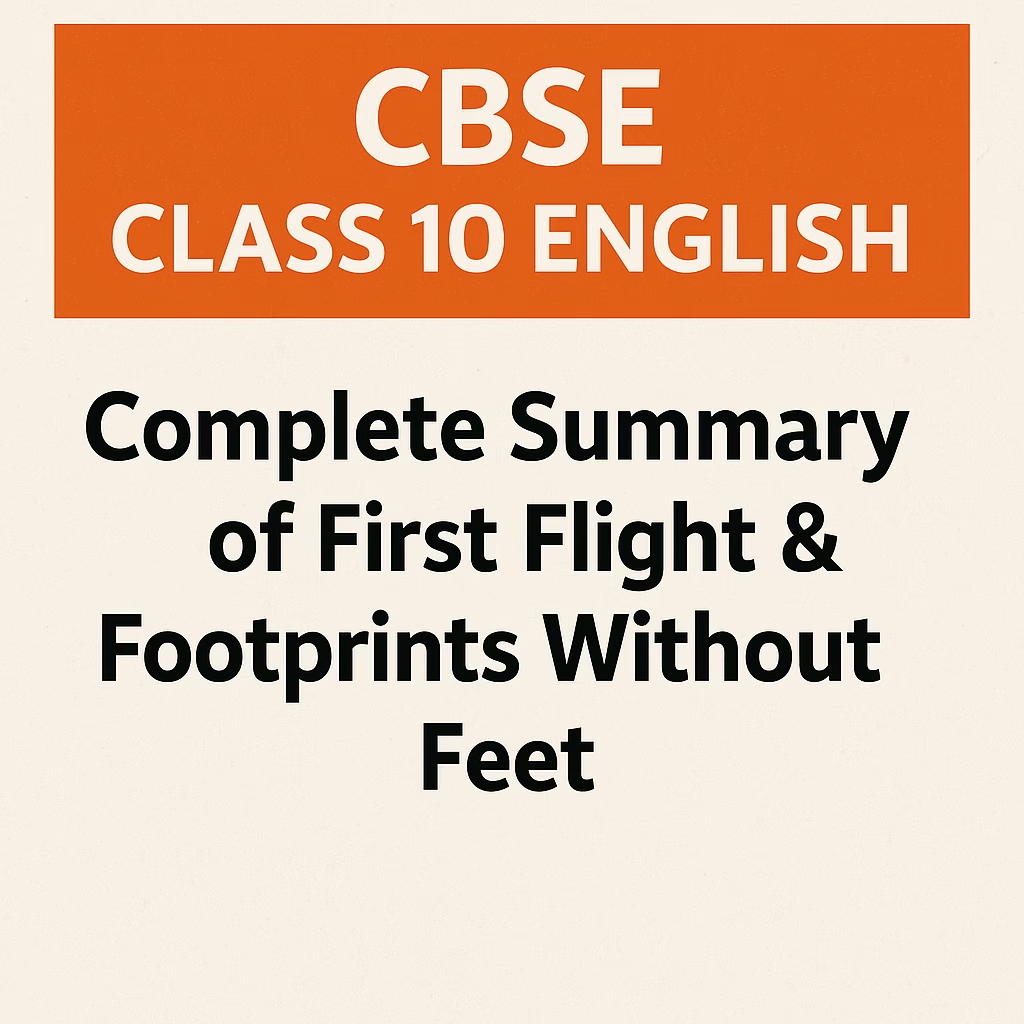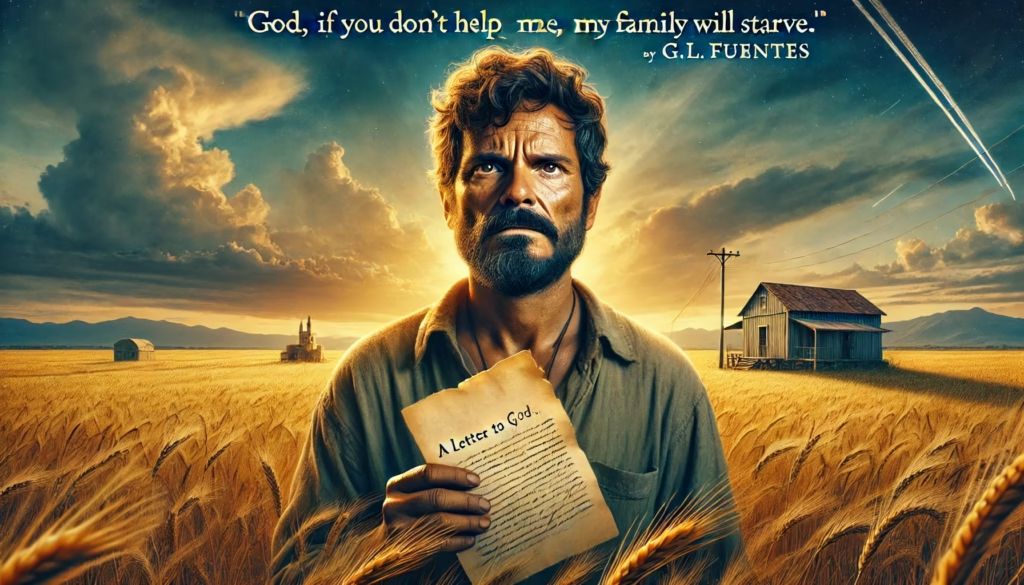
CBSE Class 10 English: Complete Summary of First Flight & Footprints Without Feet
Are you preparing for the CBSE Class 10 English Board Exam? If yes, then this blog is for you! We’ve compiled a detailed summary of all chapters from First Flight and Footprints Without Feet, along with themes, writer’s bio, and character summaries to help you ace your exam.
Here’s a detailed summary of the chapters from Class 10 English Language & Literature (Prose and Poetry) based on the chapters you mentioned from both the “First Flight” and “Footprints Without Feet” books. I’ve also included the themes, writer/poet bio, and character summaries as requested.

First Flight (Prose)
1. A Letter to God (by G.L. Fuentes)
- Summary: Lencho, a poor farmer, prays to God to send him money after a devastating hailstorm destroys his crops. He writes a letter to God requesting 100 pesos. A postmaster and his colleagues collect money to fulfill Lencho’s request. However, Lencho, believing that only God could have sent the money, angrily declares that the post office employees are thieves.
- Themes: Faith, belief in God, innocence, and human nature.
- Writer’s Bio: G.L. Fuentes was a Mexican writer known for his works reflecting Mexican rural life and social issues.
- Character Summary:
- Lencho: A devout, hardworking farmer who has unshakable faith in God.
- Postmaster: A kind-hearted individual who secretly helps Lencho, though he is misunderstood by him.
2. Nelson Mandela: Long Walk to Freedom (by Nelson Mandela)
- Summary: An excerpt from Nelson Mandela’s autobiography, this chapter reflects on his life journey, including his childhood, the struggles against apartheid, and his eventual imprisonment. It focuses on his desire for freedom and equality for all South Africans.
- Themes: Freedom, equality, struggle against oppression, hope, and resilience.
- Writer’s Bio: Nelson Mandela was a South African revolutionary and political leader who served as President of South Africa and was pivotal in the fight against apartheid.
- Character Summary:
- Nelson Mandela: The central figure, embodying courage, dignity, and dedication to the cause of equality and justice.
3. Two Stories About Flying (by Lilian H. Smith and Frederick Forsyth)
- Summary: This chapter contains two stories:
- His First Flight: A young seagull is afraid to fly but, with encouragement from his family, he overcomes his fear and takes his first flight.
- The Black Aeroplane: A pilot is flying through a storm, only to encounter a mysterious figure who guides him to safety.
- Themes: Overcoming fear, courage, the power of hope and trust.
- Writer’s Bio:
- Lilian H. Smith: An English author, known for her children’s books.
- Frederick Forsyth: A British novelist, known for thriller and suspense writing.
- Character Summary:
- Young Seagull: The protagonist who learns the importance of overcoming fear.
- Pilot: The mysterious figure symbolizes hope and help in dire circumstances.
4. From the Diary of Anne Frank (by Anne Frank)
- Summary: This is an excerpt from Anne Frank’s diary, where she describes her life in hiding during the Holocaust, the people she lives with, and her feelings about being confined.
- Themes: Hope, survival, the human spirit under oppression.
- Writer’s Bio: Anne Frank was a Jewish girl whose diary, written while hiding from Nazi persecution, became a symbol of the human tragedy of the Holocaust.
- Character Summary:
- Anne Frank: A thoughtful, introspective young girl who, despite the horrors around her, tries to maintain hope and self-reflection.
5. Glimpses of India (by Lakshmi Subramaniam)
- Summary: This story explores the diverse beauty and culture of India, from the tea gardens of Kerala to the rich heritage of the place. The author describes the distinctiveness of the land and its significance.
- Themes: Indian culture, beauty of nature, diversity.
- Writer’s Bio: Lakshmi Subramaniam is an Indian author known for her works that capture the essence of Indian traditions.
- Character Summary: N/A – This chapter is more of a description of India’s culture and landscapes.
6. Mijbil the Otter (by Gavin Maxwell)
- Summary: The story tells of the author’s relationship with his pet otter, Mijbil, and their life together in the Scottish Highlands. Mijbil, initially a wild creature, becomes a loving companion.
- Themes: Animal companionship, trust, nature, and bonding.
- Writer’s Bio: Gavin Maxwell was a British author and naturalist, known for his works about animals.
- Character Summary:
- Mijbil: The otter, who begins as a wild animal but becomes a friendly and playful pet.
- Author: The narrator who forms a bond with Mijbil and learns about the animal’s intelligence.
Apologies for the confusion! You are correct, and I appreciate your patience. Let me provide the correct summary of “Madam Rides the Bus” by V.S. Naipaul, as found in the Class 10 English syllabus.
Madam Rides the Bus (by V.S. Naipaul)
- Summary: The story is about a young girl named Valli, a curious and independent girl from a village. She longs for adventure and one day decides to ride the bus to the nearby town, despite being too young and her mother’s disapproval. She gathers the courage to board the bus on her own, pays the fare, and enjoys the ride, observing the world outside. Throughout the journey, she feels a sense of freedom and joy. However, towards the end of the journey, she is deeply affected by the sight of a dead cow being dragged along the road, which brings her back to reality and ends her carefree adventure.
- Themes:
- Independence: Valli’s determination to experience life on her own terms, despite her age and societal expectations.
- Curiosity and Freedom: The joy and excitement of discovering the world outside her own small village.
- Reality vs. Illusion: The contrast between Valli’s imagination and the harsh realities of life.
- Character Summary:
- Valli: A brave, curious, and independent young girl, eager to explore the world beyond her village. She shows maturity in her decision to ride the bus, but her adventure ends with a sobering lesson about life.
- The Bus Conductor: A middle-aged man who is amused by Valli’s courage and takes care of her during the bus ride, though he is unaware of her age at first.
- The Bus Driver: He notices Valli’s determination and allows her to ride the bus. He also plays a small role in the narrative as a part of the bus journey.
8. Sermon at Benares (by Khushwant Singh)
- Summary: The story discusses a sermon given by a Buddhist monk in Benares, where he teaches the lesson that happiness lies in self-realization, not in material wealth.
- Themes: Self-realization, inner peace, renunciation.
- Writer’s Bio: Khushwant Singh was an Indian author, journalist, and editor, known for his works on contemporary India and Sikhism.
- Character Summary:
- The Monk: A wise figure who preaches the importance of self-realization over materialism.
9. The Proposal (by Anton Chekhov)
- Summary: This one-act play is a humorous depiction of a proposal between two characters, Lomov and Natalia, who have an absurd argument over trivial matters before Lomov finally proposes.
- Themes: Marriage, social customs, humor, human nature.
- Writer’s Bio: Anton Chekhov was a Russian playwright and short-story writer, known for his mastery in writing comedies and tragedies.
- Character Summary:
- Lomov: A nervous, hypochondriac man trying to propose.
- Natalia: A fiery, argumentative woman who later accepts Lomov’s proposal.
First Flight (Poetry)
1. Dust of Snow (by Robert Frost)
- Summary: The poem describes a moment when a snowflake falls on the poet, changing his mood from sadness to joy.
- Themes: The small things in life, nature’s impact on emotions.
- Poet’s Bio: Robert Frost was an American poet known for his exploration of rural life and nature.
- Character Summary: N/A – The speaker reflects on the impact of nature.
2. Fire and Ice (by Robert Frost)
- Summary: The poem explores the destructive power of both fire (representing desire) and ice (representing hate), ultimately asking which would bring the world to an end.
- Themes: Desire, hate, destruction.
- Poet’s Bio: Robert Frost.
3. A Tiger in the Zoo (by Leslie Norris)
- Summary: The poem contrasts the tiger in captivity with the one in the wild, emphasizing the animal’s restlessness and yearning for freedom.
- Themes: Freedom, captivity, nature.
- Poet’s Bio: Leslie Norris was a Welsh poet known for his works on nature and human experiences.
4. How to Tell Wild Animals (by Carolyn Wells)
- Summary: A humorous poem that gives a description of different wild animals, offering fun ways to distinguish them.
- Themes: Humor, nature.
- Poet’s Bio: Carolyn Wells was an American poet, known for her light verse.
5. The Ball Poem (by John Berryman)
- Summary: The poem reflects on a boy losing a ball and the deep emotional experience of realizing that things can be lost.
- Themes: Loss, coming of age.
- Poet’s Bio: John Berryman was an American poet and scholar, famous for his confessional poetry.
6. Amanda! (by Robin Klein)
- Summary: The poem portrays Amanda, a young girl, who is constantly scolded by her mother for her behavior. The poem highlights her desire for freedom and independence.
- Themes: Childhood, freedom, independence.
- Poet’s Bio: Robin Klein was an Australian writer known for her works for children and young adults.
7. The Trees (by Adrienne Rich)
- Summary: The poem describes the process of trees being uprooted from their natural environment and replanting themselves in a new one, symbolizing freedom and growth.
- Themes: Freedom, nature, renewal.
- Poet’s Bio: Adrienne Rich was an American poet, known for her feminist works.
8. The Fog (by Carl Sandburg)
- Summary: The poem depicts fog as a cat-like presence that silently enters and settles over the city, creating a calm, misty atmosphere.
- Themes: Nature, mystery.
- Poet’s Bio: Carl Sandburg was an American poet known for his works capturing the essence of American life.
9. The Tale of Custard the Dragon (by Ogden Nash)
- Summary: The poem humorously tells the story of Custard, a cowardly dragon who surprises everyone by saving the day.
- Themes: Courage, bravery, humor.
- Poet’s Bio: Ogden Nash was an American poet known for his humorous verse.
Anne Gregory (by W.B. Yeats)
- Summary: The poem advises Anne Gregory, a young woman concerned with her beauty, that true love is based on inner qualities, not physical appearance. The speaker tells her that beauty fades with time, and it’s the soul that truly attracts love.
- Themes:
- Superficial beauty vs. inner beauty
- The fleeting nature of physical appearance
- True love based on character, not looks
- Poet’s Bio: William Butler Yeats was an Irish poet and playwright, a leading figure of 20th-century literature, known for his symbolic and mystic works.
- Character Summary:
- Anne Gregory: A young woman focused on her physical beauty, seeking love.
- The Speaker: Offers advice, emphasizing the importance of inner qualities over outward appearance.

Exactly !!!!
The French Revolution proves how strong ordinary people can be when they stand together for their rights…No throne or crown…
Hm..😐
that’s the situation of students nowadays. Didn’t you heard the news that a girl died after her father beaten her…


[…] Vikash Kumar HansdaClick Here for PART 1 […]